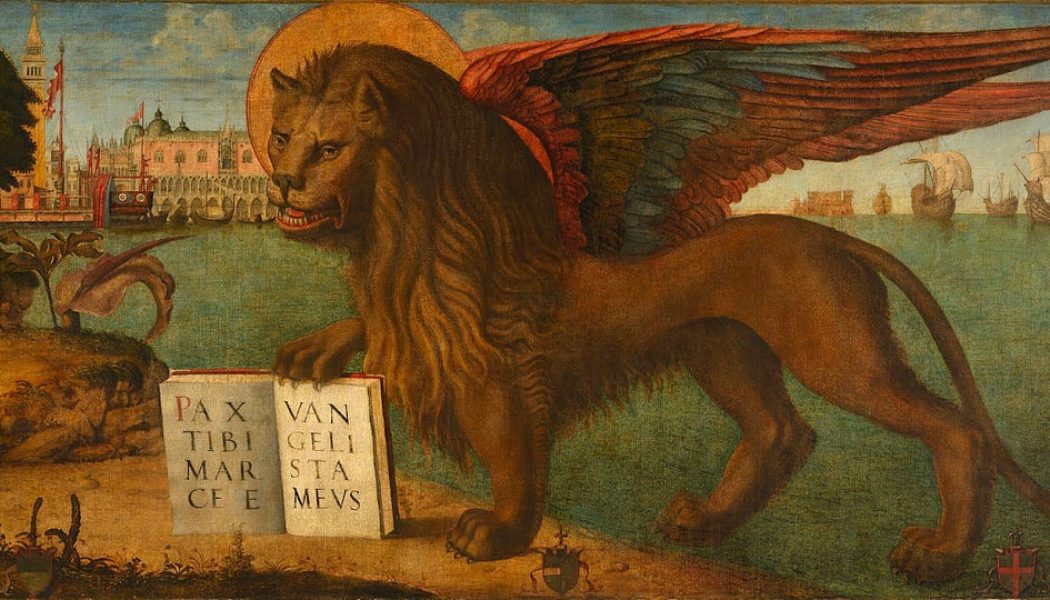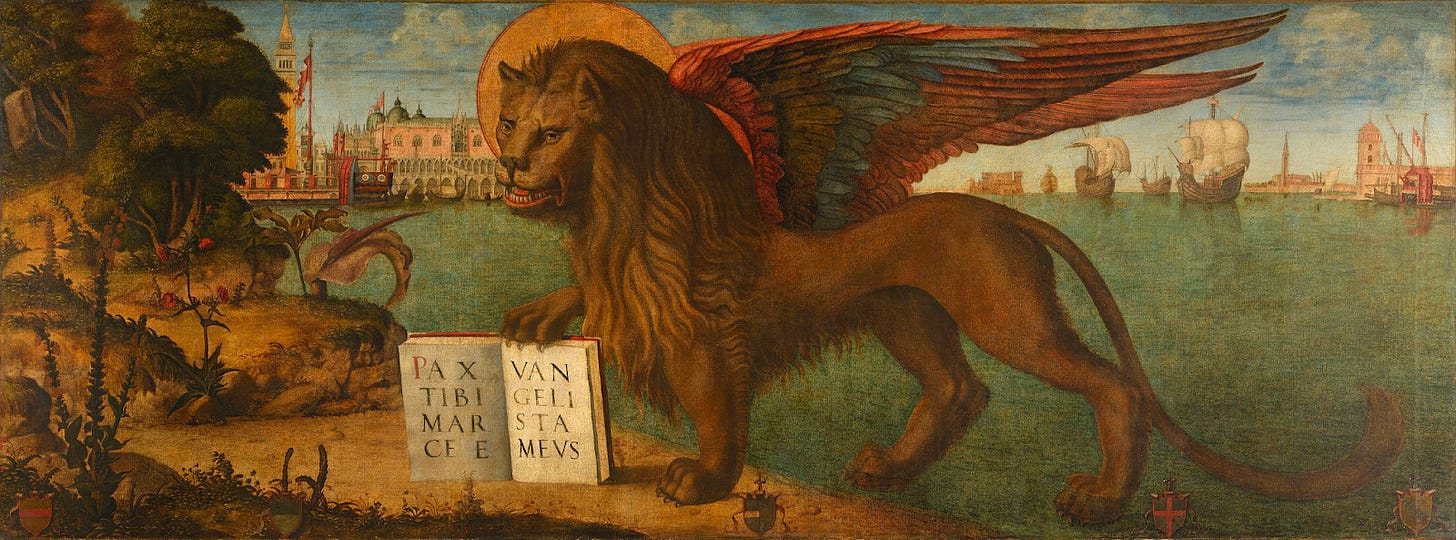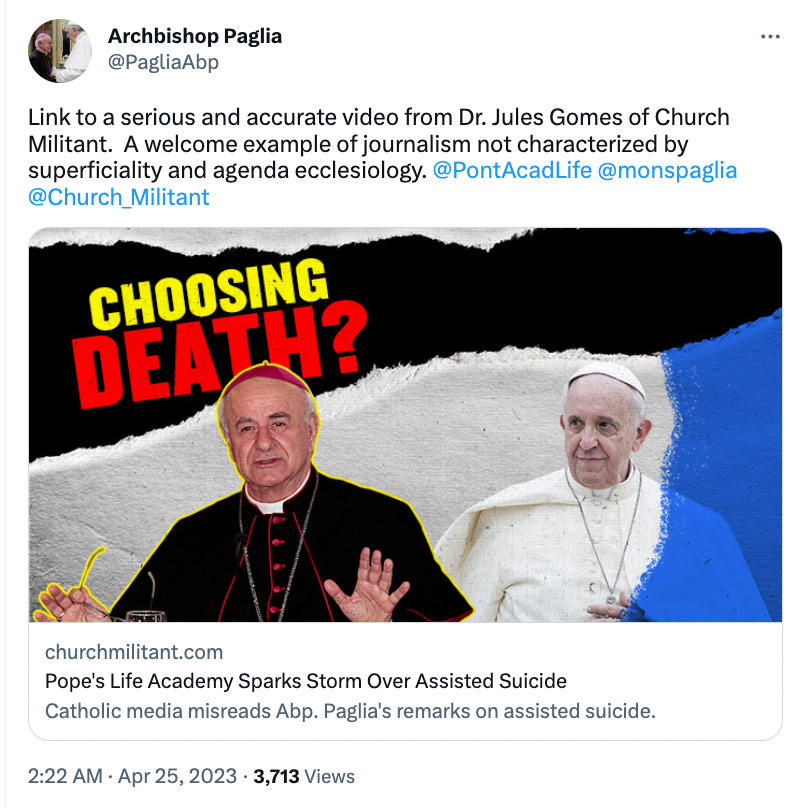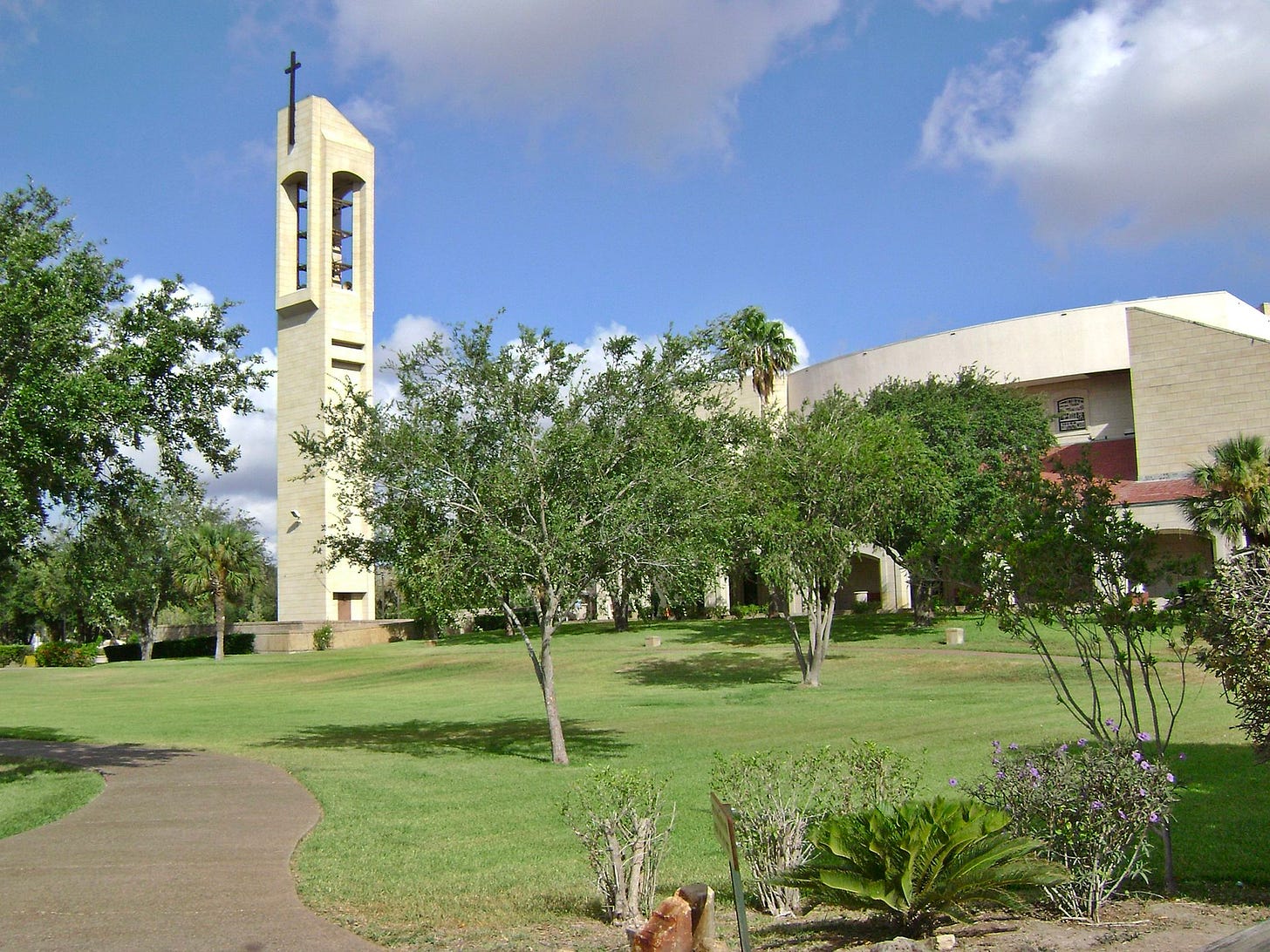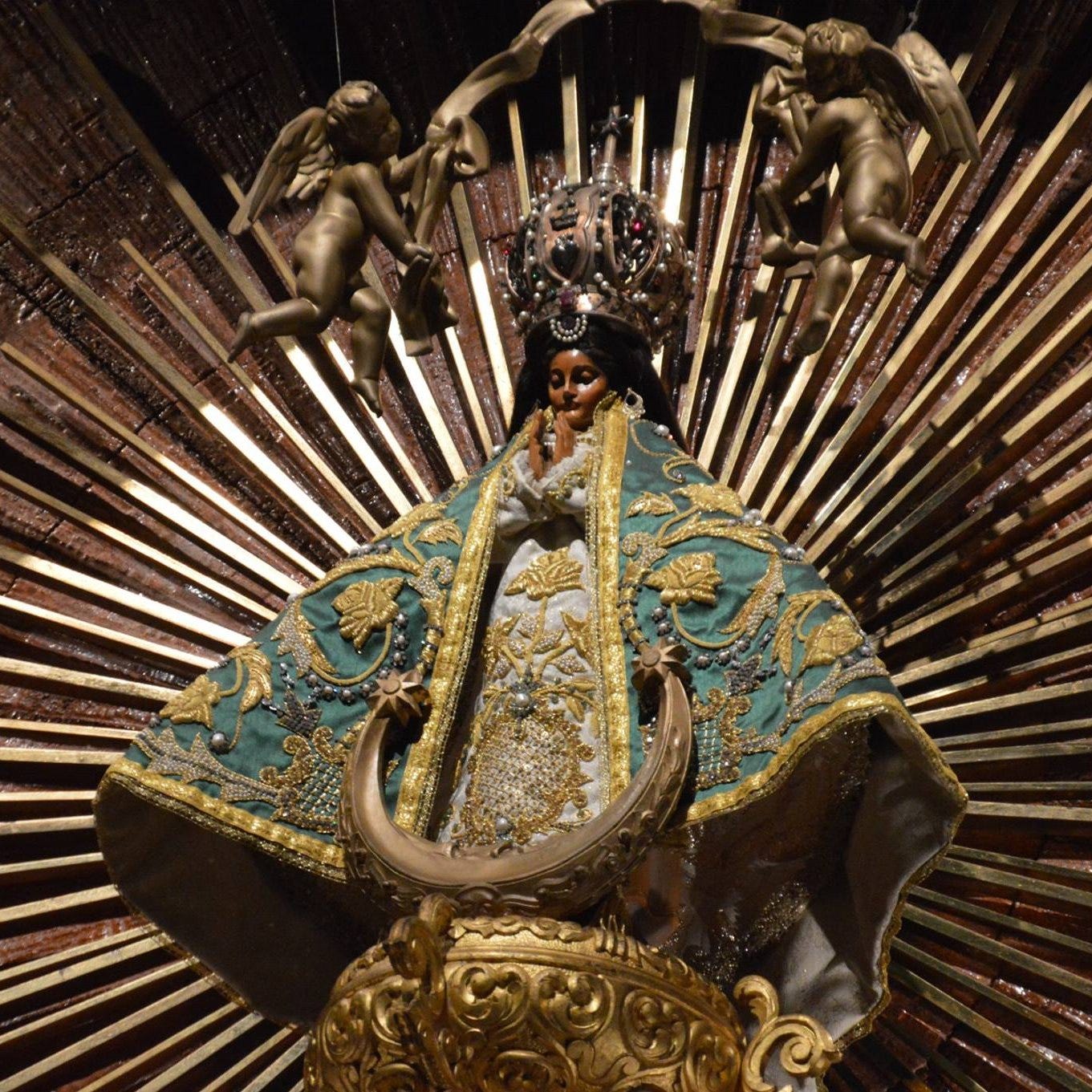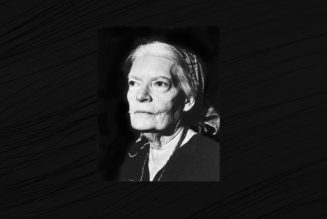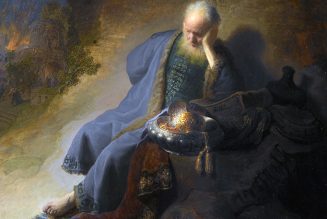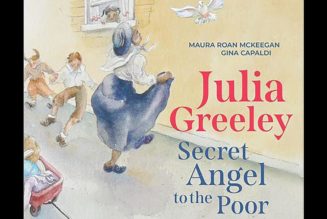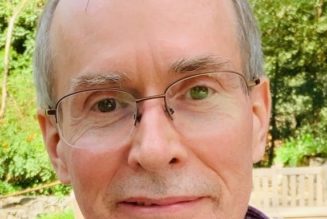Good morning!
Today is the feast of St. Mark the Evangelist, and you’re reading The Tuesday Pillar Post.
Before we get started, let me recommend to you the Gospel of Mark season of Sunday School, a most excellent Bible study podcast brought to you by our team at Pillar Media, and by our friend Dr. Scott Powell, Scripture scholar extraordinaire.
I learned a great deal about the Gospel of Mark — and about our Lord, Jesus Christ, from that season. And if you’re among the listeners clamoring for another season of Sunday School, be at peace — we’re wrapping the next season now, and I expect it will be released quite soon.
Of course, you can listen to Sunday School at Apple Podcasts, or in whatever podcast app you would prefer.
St. Mark, evangelist and disciple of the Lord, pray for us!
—
The News
Texas’ Rio Grande Valley — four counties along the U.S. border with Mexico — is among the poorest places in the U.S., and, really, also among the most beautiful.
In the RGV city of McAllen, a pregnancy center managed last October to actually purchase last year the site of the Rio Grande Valley’s only abortion clinic — and now has plans to turn the shuttered clinic into a parenting center and a “baby boutique,” distributing freely clothes, diapers, and cribs to parents who need them.
I got a tour of the closed abortion clinic last week from Yolanda Chaba, the founder of the McAllen Pregnancy Center. She told me that she believes her center will be the first to offer direct services to moms, dads, and babies on the site of a former abortion clinic.
That’s a kind of “resurrection,” she said, a sign of God’s victory of life over death.
Of course, walking through a recently-closed abortion clinic was a surreal experience. I felt moved inside to pray for the men, women, and babies whose lives were harmed — or ended — there, and for people who had worked there, during the four decades in which abortions took place inside the building.
For her part, Yolanda told me she’s aware of the spiritual dimension of transforming an abortion clinic into a place of new life. But she said she’s not afraid — she’s spent decades rooting her ministry in Mass, adoration, and frequent confession, she said — and she believes that God has opened a new door for ministry in McAllen.
She’d never expected it would be the door to an abortion clinic. But here she is.
Yolanda told me she hasn’t talked with other journalists about the clinic purchase, and she’s taken some flack from local media in Texas. But her story, and her perspective, are worth knowing.
Read the story of the McAllen Pregnancy Center — and its newly acquired clinic site — here. It is, from my view, a testimony to faith, along with a rare look inside a place of both death and new life.
The issue stems from the tax most Germans pay to the religious institution in which they are formally ascribed. The tax, which is usually 8-9% of the income tax liability to the state, is collected directly from employees’ paychecks by the state on the Church’s behalf.
It’s what makes the German episcopal conference, and German dioceses, basically fabulously wealthy.
But a growing number of Catholics are opting out of the system, and the policy of the German bishops says that those who do that should be denied the Eucharist, confirmation, serving as a godparent, or having an ecclesiastical funeral.
The Vatican has tried to put a kibosh on that practice, but the German bishops perdure — though some are now asking whether the bishops should revise their approach to disaffected Catholics, regardless of what the Vatican says.
This is a very different ecclesial context than the U.S., and our intrepid Luke Coppen breaks down the situation, and asks what might happen next.
You can read all about this taxing situation, right here.
The Institute of Catholic Culture is now enrolling new students in our upcoming free, online course: Sacred Liturgy: History & Principles of Christian Worship. Join us for a deep dive into the rich symbolism and meaning of the Mass, the Sacraments, sacrifice and worship, the liturgical calendar, and more!
Neuroscience can seem like a weird discipline — half science, half philosophy, with a healthy dose of alchemy thrown in the mix.
The human brain is mostly uncharted territory for us. As scientists begin to understand it, they’ve raised some real questions about being itself, about freedom, and about faith.
But the popular conversation about neuroscience is mostly “junk,” according to neuroscientist Sofia Carozza, an emerging researcher in her field, and a Pillar reader (in a good way).
It’s heady stuff.
Carozza talked this week with Pillar correspondent Edgar Beltran, who asked some very interesting questions about faith, reason, and the brain.
If you read this — carefully — you’re going to learn a lot. At least I did.
—
Finally, let’s talk about Archbishop Vincenzo Paglia and the Pontifical Academy for Life.
Paglia, the controversial president of the Church’s pro-life think tank, began making headlines over the weekend for a speech he gave last week, published in an Italian newspaper, in which the archbishop said that the passage of an Italian bill which would effectively decriminalize assisted suicide, under certain circumstances, might be a service to the common good in Italy.
I started getting texts early Sunday morning about the speech. Just as soon as I did, I predicted what would happen:
-
The speech would make headlines, and a social media firestorm, as Catholics fulminated over the idea that a Vatican archbishop, heading the pro-life office, would seem to call for the passage of an assisted suicide law.
-
The Pontifical Academy for Life would publish a statement, claiming that what Paglia said was completely aligned with Catholic doctrine, and that it was mostly misunderstood by conservatives, because the archbishop is simply trying to make the best of a bad situation by calling for some regulation of assisted suicide.
-
The Pillar would publish a thorough and well-researched explainer, diving into the context, explaining the backstory on Paglia and the law, and explaining both Paglia’s intervention could be seen as an effort to limit the damage of an assisted suicide law, and that the archbishop had framed his viewpoint with an argument that would continue to raise real questions.
The Pillar’s explainer would also mention the litany of scandals which have emanated from the Pontifical Academy for Life in recent years, and the archbishop’s as-yet-unfulfilled promise to sue The Pillar over our reporting on his alleged, and serious, financial misconduct.
-
The social media firestorm would continue, and among American Catholics, trust would continue to erode in the Pontifical Academy for Life’s fidelity to its mission.
Indeed, mainstream moral theologians have argued that Paglia’s approach was broadly problematic, because of its introductory claims that the Church “does not have a package of prêt-à-porter truths, prepackaged, as if it were a dispenser of pills of truth.”
One theologian called Paglia’s approach “a sad caricature of how we come to know moral truth,” while others have pointed that Paglia’s reasoning seemed to align with the Pontifical Academy for Life’s recent publications calling into question the universal applicability of Humanae vitae.
—
On my predictions, I was right, but I don’t give myself too much credit — we’ve seen enough scandals from the Pontifical Academy for Life recently that most of us know the play routes pretty well.
But here’s the development I didn’t predict, and, I’m betting, no one else did either.
Did anybody see Church Militant coming out behind Paglia on this one? Or Paglia boosting the site as a welcome ally?
Is this a new Church Militant? Or do ecclesiastical politics simply make strange bedfellows sometimes? In either case, I’m guessing you didn’t have that on your bingo card.
—
The shrine, and the museum
I was, as I mentioned to you above, in the Rio Grande Valley of Texas for a couple of days last week, and I stayed at the most interesting American basilica you’ve probably not heard of.
The basilica of Our Lady of San Juan del Valle, a national shrine, got its start in the 1940s, when a priest of the Oblates of Mary Immaculate began fostering at his parish a devotion to Our Lady of San Juan Della Valle, a title for the Blessed Virgin Mary popular in Mexico since the 1600s.
A statue of Our Lady del San Juan del Valle at the Texas parish became a focal point of devotion in the early 1950s, especially among migrant families who had come north to Texas from communities in Mexico.
The community in San Juan, Texas built a shrine, which was dedicated in 1954 with some 60,000 Catholics present.
And then in 1970, something extraordinary happened.
On October 23, 1970, some 60 priests from the RGV were meeting at the shrine, and a group of some 70 children were in the same building having lunch in the cafeteria. By some accounts, the priests might have been concelebrating a Mass.
Overhead, a math teacher named Frank Alexander was piloting a rented Piper Cherokee.
Around 11:30 a.m. Alexander, 52, radioed the control tower at McAllen airport. He told controllers that all Catholic and Methodist churches should be evacuated, because, he said, “there’s a serious plot.”
Then he went silent on the radio.
A half hour later, Alexander’s plane crashed directly into the shrine of Our Lady of San Juan del Valle.
The building erupted into flames. The burning fuselage of his plane crashed into the cafeteria. But miraculously, the children, the religious sisters who taught them, and the priests in the building all escaped unharmed. Alexander was the only fatality.
Police later said that Alexander had been “hanging around the police station” in the weeks before his crash, “acting a little bit strange.”
The shrine was rebuilt — albeit, not in the Mexican baroque style of the original church.
But in the ensuing decades, it has quietly become one of the most popular pilgrimage destinations in the United States — by some accounts, it receives more than 1 million visitors a year. Confessions are offered for hours each day.
And the priest who runs the shrine, Fr. Jorge Gomez, told reporters in 2021 that some 10,000 candles are lit at the shrine each week, by pilgrims who come to pray for special intentions.
Outside the shrine are two-fan cooled buildings, where candles burn down on wire racks after they’re removed from the church.
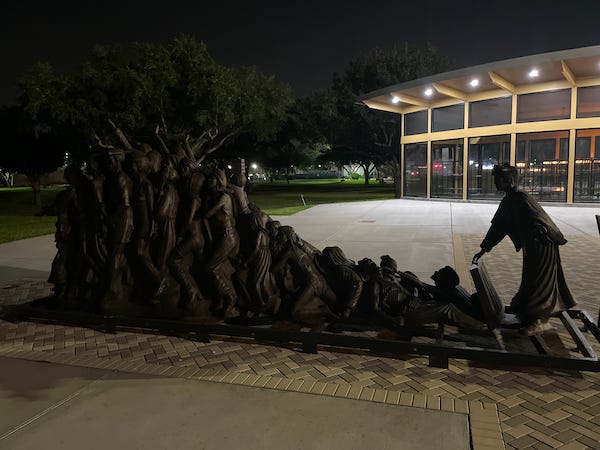
It’s quite cool.
Now, before I’d visited, I had not heard of the basilica shrine of Our Lady of San Juan del Valle.
Perhaps you have, and I’m the last Catholic in America to hear the news.
But if you haven’t, and you’re in driving distance, consider a pilgrimage. It was a pretty cool place to see.
And across the street is the Gelman Stained Glass Museum, which bills itself as “home to the most comprehensive collection of stained-glass windows in the United States.”
The museum was apparently started, at least by the story locals told me, when the pastor at the shrine declined to accept a massive collection of stained glass offered by a donor, who decided that if the church didn’t want his windows, he’d set up shop across the street.
I don’t know if that is true, but I really hope it is. It cracks me up.
—
In closing, a pitch.
We’ve been talking this week with a religious sister who told us that she depends daily on The Pillar to get a fair, clear, and smart take on what’s happening in the life of the Church.
I sat down this weekend with a religious priest I’d never met, and the first thing he told me is that his entire house reads The Pillar, and frequently debates the issues they read.
Last week, I was visiting a house of retired priests, and one stopped me to say that The Pillar’s Starting Seven is what he reads to stay connected to the Church — and to (gently) ask me why the heck we’d taken Easter Week off, leaving him high and dry.
Guys — I am extremely proud that our news site is where men and women of the Church actually turn order to know what’s going on. I’m proud when bishops, or religious sisters, or parish and chancery employees, tell me The Pillar is the Catholic news they trust.
That’s what we’re shooting for. And we’re very proud we can keep our news free so that men and women of the Church — lay, clerical, or religious, can read it, and depend on it.
But some of them can’t afford to subscribe. They depend on those of you who can.
To meet our internal subscription goals — the ones that tell us we can afford to do the journalism that matters — we need ~150 more subscriptions in the month of April. We’re close to our internal goals, but we’re not there.
We have a little bet going: One of us thinks we’ll get close to meeting the goal, but not make it. The other of us believes that from the tens of thousands who read this newsletter, we have 150 readers of The Pillar who are ready to subscribe.
I am not asking for charity here. We are a newsstand with an honesty box. If you’re reading this and think The Pillar is worth paying for, we ask you to pay for it, if you can.
And I am reminding you that when you pay, you keep The Pillar available to religious sisters and brothers, to retired priests, to seminarians — to people who tell us they depend on our coverage.
If you can become a paying subscriber, we’re grateful.
If not, we’re still grateful for you. Thanks for being a part of this community.
—
Blessed feast of St. Mark.
Please be assured of our prayers. And please pray for us. We need it.
Yours in Christ,
JD Flynn
editor-in-chief
The Pillar
The Institute of Catholic Culture is now enrolling new students in our upcoming free, online course: Sacred Liturgy: History & Principles of Christian Worship. Join us for a deep dive into the rich symbolism and meaning of the Mass, the Sacraments, sacrifice and worship, the liturgical calendar, and more!
Comments 5
Services Marketplace – Listings, Bookings & Reviews
